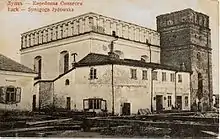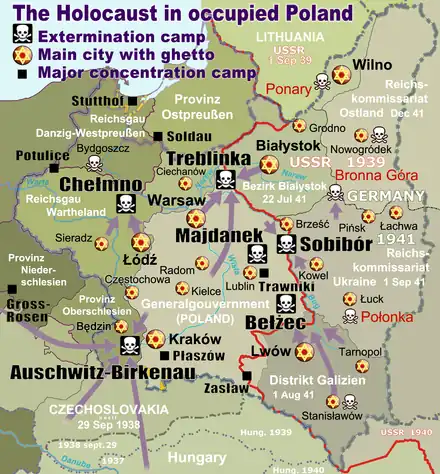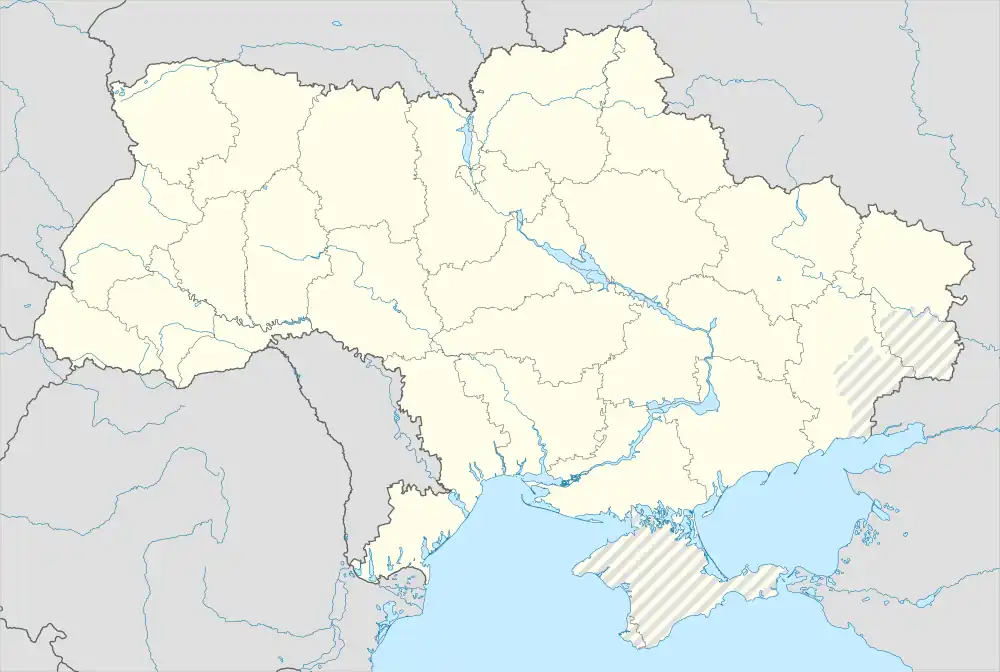| Lutsk Ghetto | |
|---|---|
 Great Synagogue, Lutsk before its virtual destruction in World War II | |
 Lutsk location during the Holocaust | |
 Lutsk Ghetto Lutsk in modern-day Ukraine | |
| Location | Lutsk, Western Ukraine 50°27′N 25°12′E / 50.45°N 25.20°E |
| Incident type | Imprisonment, slave labor, mass killings |
| Organizations | SS, Einsatzgruppe C, Ukrainian Auxiliary Police, Wehrmacht |
| Executions | Górka Połonka (see map) |
| Victims | 25,600 Jews[1] |
The Lutsk Ghetto (Polish: getto w Łucku, German: Ghetto Luzk) was a Nazi ghetto established in 1941 by the SS in Lutsk, Western Ukraine, during World War II. In the interwar period, the city was known as Łuck and was part of the Wołyń Voivodeship (1921–1939) in the Second Polish Republic.[2]
Background
Łuck was in the eastern part of prewar Poland throughout the interwar period. According to Polish census of 1931, Jews constituted 48.5% of the Łuck's diverse multicultural population of 35,550 people.[3] Łuck had the largest Jewish community in the province.[4] The secret Molotov–Ribbentrop Pact meant that during the Nazi-Soviet invasion of Poland in 1939 Łuck was conquered and occupied by the Red Army. The region was Sovietized in an atmosphere of terror.[5][6] Political, communal and cultural institutions were shut down, and Jewish community leaders were arrested by the NKVD.[7] In June 1940 the Soviet secret police uncovered the Zionist "Gordonia" organization and imprisoned its leaders. Polish-Jewish families who fled to Łuck from western Poland ahead of the Nazis were rounded up and deported to the Soviet interior,[7] along with train-loads of dispossessed Christian Poles.[8] Some 10,000 people were sent in cattle trains to Siberia in four waves of deportations from the Łuck county beginning in February, April and June 1940.[9]
NKVD prisoner massacre
The German Wehrmacht invaded the Soviet Union on June 22, 1941, in Operation Barbarossa. Many young Jews left Łuck with the retreating Red Army,[7] but very few Jewish families followed them.[10] The escaping NKVD, responsible for political prisons, purported to offer amnesty to the inmates of the Łuck prison and in the morning of June 23 ordered them to exit the building to the courtyards en masse.[11] The gates were locked, and all prisoners were mowed down by heavy machine guns and grenades thrown from prison windows; 2,000 people died on the spot.[12] A small group of survivors was forced by the NKVD to bury the bodies over the next two days, in five mass graves.[13] In total, some 4,000 captives including Poles, Jews and Ukrainians were murdered by the Soviet secret police before their withdrawal.[14]
The Germans rolled into the city on June 26, 1941. They overlooked the Soviet killings of Poles and Jews. But the killings of Ukrainians were documented, and, by the Nazi ideology of Judeo-Bolshevism, the Jews were to be held responsible for what the Soviets did. The Ukrainian People's Militia vented their rage by organizing a pogrom. The Synagogue along with the Jewish homes were set on fire.[15] The Nazi's wave of mass executions began a week later. A mobile killing squad, Einsatzgruppe C's Einsatzkommando 4a, assisted by an infantry platoon, massacred 1,160 Jews on July 2.[16] On July 4, 1941 at Lubart's Castle 3,000 Jews were shot and killed by heavy machine gun fire.[2] Overall, some 2,000 Polish Jews were murdered by the SS-Sonderkommando 4a alone, as reprisal for the NKVD killings of Ukrainians (9.2 percent of population in 1931),[3] even though Polish Jews had nothing to do with the Soviet atrocities.[15]
Ghetto history
The draconian restrictions on Jews were imposed in August 1941. In October, a group of 500 Jewish carpenters and craftsmen (including 50 seamstresses)[17] were moved to a new forced labour camp set up in the Jewish school building.[18] The Łuck Ghetto was established by the German occupation authorities in December 1941,[7] and sealed from the outside with the provision of only starvation food rations.[7] The ghetto population was about 20,000 people.[18] The newly formed Judenrat, a council of Jewish leaders for the ghetto, made every effort to feed the hungry and control epidemics.[7][19] The Jewish Ghetto Police was also organized by the Judenrat.[1]
Jewish uprising and the ghetto liquidation

The fate of ghettoised Jews across occupied Poland was sealed at Wannsee in early 1942, when the Final Solution was set in motion. The first large-scale aktion in the Łuck Ghetto took place on August 19, 1942. About 17,000 Jews were rounded up by Nazi Order Police battalions and the Ukrainian Auxiliary Police during a four-day period,[17] assembled at the square by the pharmacy, and taken in lorries along with women and children, to the Górka Połonka forest,[20] on the outskirts of Łuck (see map).[1] They were shot into the prepared trenches. During the deportations, the small ghetto in Hnidawa (Gnidawa) was also emptied. A few families survived in the pharmacy cellars, including eyewitness Shmuel Shilo (age thirteen), along with his mother and brothers; Shmuel's sister was rescued by the Poles.[1] Meanwhile, the labor camp remained in operation for a few more months.[7] The main ghetto ceased to exist; Jews who were still alive were relocated back to the small ghetto in Gnidawa.[1] They were rounded up on September 12 and marched to Lubart's Castle; from there, they were to Połonka and murdered. Young Shmuel Shilo survived again, but all alone this time; he hid under a floor plank in the castle for two nights.[1]
In the final extermination phase of Operation Reinhard, on December 12, 1942 the German and Ukrainian police entered the camp building of the former Jewish school to conduct the liquidation of the SS enterprise. The Jews barricaded themselves inside determined to die in combat. They did not have guns; they had axes, pickaxes, factory tools and bottles of acid.[18] The siege lasted for the entire day. The Germans used artillery to suppress the resistance. Towards the evening, the police forces set the building ablaze, and machine-gunned any escaping prisoners. The rare eyewitness, Shmuel Shilo who found refuge with the insurgents, survived again, this time by hiding beneath a work bench; he jumped out the window under the cover of night.[17] The revolt took place in the depth of winter, four months before the Warsaw Ghetto Uprising of April 1943.[17][18] The Łuck Ghetto was liquidated entirely through the Holocaust by bullets (as opposed to the Holocaust by gas).[21] In total, more than 25,600 people were executed at point-blank range at Połonka,[1] men, women and children.[10] Several participants of the rebellion escaped to freedom.[18]
End of World War II
The Red Army rolled into the city on February 2, 1944. Only about 150 Jews emerged from hiding,[10] including families of Dr. Faiwel Goldstein, Dr. Schneiberg and Dr. Marek Rubinstein rescued by the Catholic families of Strusińskis,[22] and Ostrowskis,[23] Polish Righteous Among the Nations from Łuck and nearby farm in Kroszowiec respectively.[23] Zygmunt Strusiński received his Righteous medal posthumously, murdered for saving Jews in winter 1943.[22] His wife Wiktoria, expelled from USSR along with all Poles in 1945, corresponded with the survivors from Israel for decades to come. She did not sell any of the jewellery given by Jews in hiding to buy food for them, and gave it back with a sense of pride during a visit in 1963.[22]
Following World War II, at the insistence of Joseph Stalin during Tehran Conference confirmed (as not negotiable) at the Yalta Conference of 1945, Poland's borders were redrawn and Łuck – then again, Lutsk (Cyrillic: Луцьк) – was incorporated into the Ukrainian SSR of the Soviet Union.[24] The remaining Polish population was expelled and resettled back to new Poland before the end of 1946. The Jewish community was never restored. The USSR officially ceased to exist on 31 December 1991.[25][26]
See also
- Stanisławów Ghetto in occupied eastern Poland
References
- 1 2 3 4 5 6 7 Yad Vashem, Mass-murder of Łuck Jews at Gurka Polonka in August 1942 on YouTube Note: village Połonka (Polish: Górka Połonka or its Połonka Little Hill Archived 2008-07-20 at the Wayback Machine subdivision) is misspelled in the documentary, with testimony of eyewitness Shmuel Shilo. Retrieved July 24, 2015.
- 1 2 Joshua D. Zimmerman (2015), The Polish Underground and the Jews, 1939–1945. Cambridge University Press via Google Books, p.193. "The Home Army nevertheless noted armed resistance in the Łuck ghetto. Consequently, some managed to flee and join partisan groups in the forests."
- 1 2 Central Statistical Office (Poland), Drugi Powszechny Spis Ludności. Woj.wołyńskie, 1931. PDF file, 21.21 MB. The complete text of the Polish census of 1931 for the Wołyń Voivodeship (1921–39), page 59 (select, drop-down menu). Wikimedia Commons.
- ↑ Wydarzenia 1931 roku. Historia-Polski.com. Wykaz miast RP z populacją żydowską powyżej 12 tysięcy. Łuck: 17.366 czyli 48% ludności.
- ↑ Bernd Wegner (1997). From peace to war: Germany, Soviet Russia, and the world, 1939–1941. Berghahn Books. p. 74. ISBN 1-57181-882-0.
- ↑ Marek Wierzbicki, Stosunki polsko-białoruskie pod okupacją sowiecką. Bialorus.pl (Warszawa), pp. 1/3. (in Polish)
- 1 2 3 4 5 6 7 Dr Pawel Goldstein, Lutsk (Luck) Ghetto. Geni.com. "In the spring of 1942 a group of young Jews attempted to escape from the ghetto to the forests, but most of them were caught and murdered by the Ukrainians. A few, however, managed to join the Soviet partisans and fought the Germans as part of the Kowpak units."
- ↑ Tadeusz Piotrowski (1998), Poland's Holocaust (Google Books). Jefferson: McFarland, pp. 17-18, 420. ISBN 0-7864-0371-3.
- ↑ Feliks Trusiewicz, Zbrodnie – Ludobójstwo dokonane na ludności polskiej w powiecie Łuck, woj. wołyńskie, w latach 1939–1944. (War crimes committed against Polish nationals in the Łuck county, 1939–44). Retrieved July 22, 2015.
- 1 2 3 YIVO Encyclopedia of Jews in Eastern Europe, Lutsk. In the spring of 1942, a group of youths was killed trying to escape. Following the Soviet liberation of Łuck in February 1944, only about 150 Jews returned. By 1959, just 600 Jews were living in Lutsk. The fortified synagogue was turned into a movie theater and later into a sports hall. A residential area was constructed on the site of the Rabbinite and Karaite cemeteries.
- ↑ Berkhoff, Karel Cornelis (2004). Harvest of Despair. p. 14. ISBN 0-674-02078-2. Retrieved July 22, 2015.
- ↑ Władysław Siemaszko (22 June 2011). "Lato 1941 – polski dramat" [Summer of 1941 – The Polish Drama] (PDF). IPN Bulletin. Institute of National Remembrance (Special Issue. On the 70th Anniversary of Prisoner Massacres): 8. Retrieved 5 August 2015. Document size 1.63 MB.
- ↑ Berkhoff 2004, p. 241.
- ↑ Piotrowski 1998, p. 17.
- 1 2 Ronald Headland (1992), Messages of Murder: A Study of the Reports of the Einsatzgruppen of the Security Police and the Security Service, 1941–1943. Fairleigh Dickinson Univ. Press, p. 125. ISBN 0-8386-3418-4.
- ↑ Headland 1992, chpt. Army Cooperation with the Einsatzgruppen, p. 141.
- 1 2 3 4 Yad Vashem, testimony of Shmuel Shulman (Shmulik Shilo), Liquidation of the Jewish inmates of the Łuck labor camp in December 1942 on YouTube. Retrieved July 21, 2015.
- 1 2 3 4 5 IZRUS (October 2011). "The forgotten December". The fall of "masada" of Western Ukraine. The Berdichev Revival. Testimony of one of the few surviving participants in the revolt, Shmuel Shilo from Kibbutz Tseelim, is preserved in the Book of Memory of Lutsky Jews "Sefer Lutsk" (translated from Hebrew). Retrieved 21 July 2015.
- ↑ Yad Vashem, Luck, town. On September 3, 1942 about 2,000 Jews who remained in the Luck ghetto were shot near the city. 2. On December 12, 1942 ca. 100 (500) Jewish craftsmen, the last surviving Jews in the work camp, were killed.
- ↑ Andrzej Mielcarek, Wieś i kolonia Hnidawa, inaczej Gnidawa, powiat Łuck; Archived 2007-03-28 at the Wayback Machine Gromada Połonka. Archived 2007-09-17 at the Wayback Machine Interactive 1936 map included. Strony o Wołyniu Wolyn.ovh.org in Polish. Retrieved July 24, 2015.
- ↑ "The Holocaust by bullets" by National Geographic Channel on YouTube Retrieved 20 July 2015.
- 1 2 3 Maria Ciesielska (2014). Klara Jackl (ed.). "Rodzina Strusińskich". Muzeum Historii Żydów Polskich. Archived from the original on 16 July 2016. Retrieved 26 July 2015.
- 1 2 Wojciech Załuska (2012). "The Ostrowski Family". Muzeum Historii Żydów Polskich. Translated by Andrew Rajcher. Archived from the original on 3 August 2016. Retrieved 26 July 2015.
- ↑ Glenn Dynner, François Guesnet, Ghetto of Łuck. BRILL 2015, p.462; Warsaw: The Jewish Metropolis, ISBN 90-04-29181-4.
- ↑ Sylwester Fertacz (2005), "Krojenie mapy Polski: Bolesna granica" (Carving of Poland's map). Magazyn Społeczno-Kulturalny Śląsk. Retrieved from the Internet Archive on 5 June 2016.
- ↑ Simon Berthon; Joanna Potts (2007). Warlords: An Extraordinary Re-Creation of World War II. Da Capo Press. p. 285. ISBN 978-0-306-81650-5.